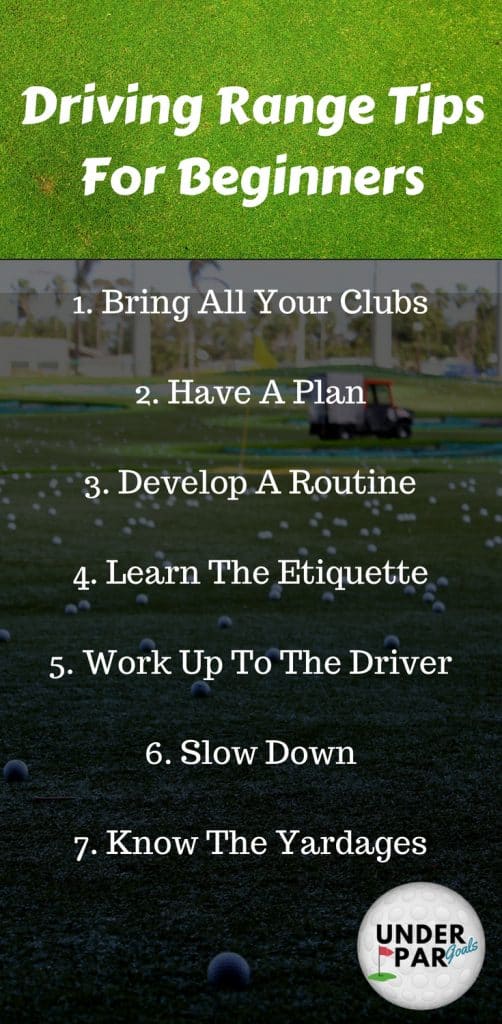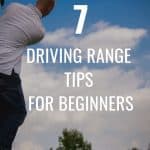As a beginner golfer, many aspects of the game can seem intimidating. Maybe second only to the first tee is a crowded practice range where it feels like all the eyes are on you.
You may be a little self-conscious, you many not know how to act, and you don’t want to upset the other golfers who all look like they know what they are doing. All these things can prevent you from enjoying your time at the range, hinder your improvement, or may even stop you from practicing altogether.
These driving range tips for beginners are a great way to help you feel more comfortable, develop a plan and routine, and get the most out of your range sessions. You’ll get past beginner status in no time!
1. What Clubs To Take To The Driving Range
Well…what clubs do you take to the golf course?
All 14 of them?
Great, then that’s what you should take to the driving range. Most ranges will allow you to bring your golf bag to the range. I avoid the ones that don’t because that tells me that they aren’t catering to golfers that want to practice their game.
Why bring all your clubs? Simply because you want to be able to switch off various clubs during your practice routine. There may be times when you just want to focus on one or two clubs during a practice session and there’s nothing wrong with just bringing those clubs for a short session. But in general, it is always helpful to have other clubs available if you get frustrated, bored, or simply want to vary your practice.
This is a question that we get so much here that we wrote an entire article about it. That article goes into a little more detail about deciding what clubs to use and developing a plan of attack each time you hit the range.
If you’re a beginner and unsure which clubs you should get, check out our guide on the Best Golf Clubs For Beginners.
2. Have A Driving Range Practice Plan
If you show up to the range and just start hammering balls out into the open field until they are done, then you aren’t really playing golf, you’re just exercising your arms.
You’d be better off doing that at a gym.
You need a plan whenever you go to the driving range.
I’m not saying you need to be super focused and working on a specific skill every single time you go to the range. Sometimes your plan can be just to have some fun. That’s a valid plan. Golf is supposed to be fun. But if you want to actually improve on something, make that your plan. You’ll see results much faster.
To develop a practice plan, you need to know where your weaknesses are. A great way to accomplish this is to track certain basic statistics such as greens hit, fairways hit, clubs used off the tee, short game up and down percentage, and whatever else you feel is important to you. By looking at those stats, you can decide more intelligently what to work on at any particular time.
If you want to take your practice sessions to the next level, click this link to check out our downloadable Driving Range Practice Guide.
3. Develop A Driving Range Routine (Then Break It)

We’ve all been there. You start striping that 7 iron right to the target green…shot after shot after shot. Then, all of a sudden, your bucket is empty and all you did was hit a hundred 7 iron shots in a row. When do you think you’ll need that many 7 irons in a row on the course?
If you said never, then you probably realize that’s a bad way to practice.
There is nothing wrong with using the same club multiple times in a row, especially if you are working on a specific part of your swing. The repetition helps and not having to change clubs lets you be super focused on one small part of your swing. That is what I would call technique practice.
However, technique practice is only part of what you need to work on. You also need to practice making shots. In other words, practice hitting specific yardages to specific targets. When you are doing this, you don’t want to be focusing on technique, you want to focus on your pre-shot routine, lining up to the target, and executing a shot as if you were on the course.
When practicing shotmaking, it can be very helpful to change targets every shot. After all, you rarely have to make the same shot two times in a row on the golf course.
So keeping this all in mind, develop a routine ahead of time to work on specific skills or techniques associated with your swing and then once you feel comfortable with that, break that routine and pick targets at random and attempt to make shots to those targets.
4. Learn Driving Range Etiquette
Driving range etiquette is a little different than golf course etiquette, but it is still important to learn.
Driving ranges can vary from the more serious practice facilities all the way to a more relaxed facility with kids and families having fun. Part of good driving range etiquette is recognizing what kind of facility it is. You need to adjust your expectations based on the kind of range it is. Grass ranges at a golf course tend to be more geared towards golfers practicing their skills or warming up for a round. You can expect these places to be quieter and closer to what you can expect while you are on the course.
A practice range with multiple floors, artificial turf, rubber tees, and a snack bar tend to cater to more casual golfers (or even non-golfers) who are just there to have fun. These facilities tend to be louder, have more distractions, and tend to be more like a bowling alley than an actual tee on the course. You may think this is bad for practicing, but there can be some benefits to learning to make shots with a lot of distractions.
You should also do your best to be respectful of other golfers around you. Spread out from other golfers if there is room. This may not always be possible, but when it is, try to give others some space. This is especially true if you are at a grass range and there are no dividers. As a beginner, you may hit some errant shots. For most beginners, this can sometimes mean hitting into the divider in front of you (if there is one). If you have a tendency to do that, position yourself accordingly so other golfers don’t have to fear for their lives!
In general, be aware of your surroundings. Try to be polite and respectful of others, and focus on your own swing.
5. Don’t Start With The Driver (Maybe Sometimes)
Beginners tend to instinctively grab the big stick as soon as they get to the range and start swinging for the fences.
Try to fight this instinct.
First of all, you probably can’t make an effective full swing with the driver until you warm up and loosen up a little.
More importantly, when you warm up for an actual round of golf, you probably start with short shots and work your way up to the driver right before you head to the first tee. Developing a good warm up routine that loosens your muscles and get’s you ready to hit that first tee shot is important. The driving range is a great place to develop that routine.
But maybe start with the driver occasionally. We’ve all had those days where we got held up and arrived at the course to find our group waiting on the first tee for us. No warmups, barely any stretching, and you need to rip that first drive down the fairway. So why not occasionally recreate that scenario. When you arrive at the driving range, take one ball (only one) and tell yourself you need to put it in the fairway. Then go into your normal routine.
That occasional departure from the normal routine may prove valuable the next time you are running late.
6. Slow Down!
How many of you have paid for your bucket of balls, went out to the range, hit a bad shot, got frustrated, grabbed another ball quickly, repeated that, and all of a sudden realized that you are halfway through your bucket in 5 minutes?
That is a good indication that you need to slow down!
Think about how you play a round of golf. Do you hit shot after shot in rapid succession? No.
If you play a round of golf in 4 hours and shoot 90, that’s 2 minutes and 40 seconds between shots on average. Since your putts usually happen quicker, that means even more time between the full swing shots.
So practice like you play. Take your time setting up to each shot. Go through your pre-shot routine. Pick a target. Line up the shot as if you were on the course. Then make your swing.
If you do that for every shot at the range, then next time you get on the course you’ll be much more comfortable hitting each shot. As an added benefit, you won’t need to spend $15 on that super jumbo bucket of balls at the range!
7. Know The Yardages
I have never played on a golf course where my target was the size of a football field.
Even at the driving range, you need to know where your shots are ending up. Hopefully, your local range has flags or some type of targets that you can hit to. If you have a choice, pick one that does. If you can’t find one that has targets, try to find some variations in the ground or any thing you can identify as a target for yourself.
Click here to check out our guide to buying the best golf rangefinder. There are a lot of choices out there so this guide should take the guesswork out of making a good choice.
Knowing exact yardages will make it easy to get comfortable hitting to specific yardages and also give you confidence when you pull a club on the course. I’d suggest keeping track of the yardages you hit each club until you are comfortable enough with the yardages to remember them.
The next step is to know the yardages of those targets. Some ranges will have flags with marked yardages. This is certainly preferable but be aware that even if they are marked, they may not be accurate.
If they are not marked, then you need to figure it out yourself. You can’t walk off yardages on a range like you can on the course so the best way to get specific yardages is with a laser rangefinder (my rangefinder is probably my most useful piece of equipment). If you don’t have a rangefinder, you can try asking the people that work there but don’t expect much.
A final note on driving range yardages…
Many ranges use golf balls that are designed to fly shorter than the ones you use on the course. There is not good way to know this other than to also check your yardages on the course. Most range balls will fly about 10% less than a good quality playing ball. Some “limited distance” range balls can be up to 20% or even 30% less than normal golf balls.
8. Don’t Get Lazy
Even at the driving range, you should be hitting every shot with purpose.
Whether that purpose is to hit a target, hit a shot shape, get the club into a certain position in the swing, or something else, it doesn’t matter…as long as you have a purpose for the shot.
Some Other Resources For Beginners
- Golf Balls That Are Great For Beginners
- Putters That Can Help High Handicap Players
- Training Aids To Help Your Putting
Do You Have More Driving Range Tips?
Whether you are a beginner or long time golfer, what advice would you give to beginners to make the most of their driving range sessions?
Click below to join the discussion on Facebook and to share your knowledge and past experiences.
[elementor-template id=”2098″]



Patience, don’t rush, and go to the range with a purpose.